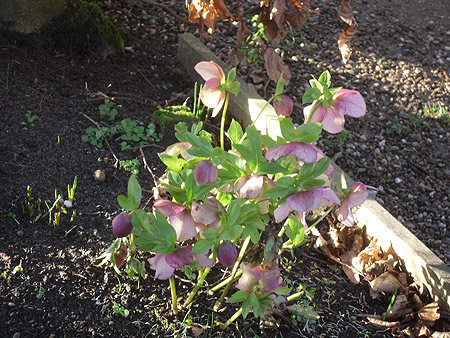
| HOME |
| NERVE |
| REVIEWS |
| ARCHIVE |
| EVENTS |
| LINKS |
| ABOUT US |
| CONTRIBUTORS |
| BACK ISSUES |
| CONTACT US |
 |
Fireweed*
By Sandra
Gibson
Photograph by Geoff Edwards
February Flowers for Valentine’s Day
February 2013
It’s likely that Geoffrey Chaucer was the first writer to link Valentine with romance. His poem Parlement of Fowles introduces the notion of St Valentine’s Day as a time for the pair bonding of birds and hence of love birds from our own species. After the dreariness of winter and the failure of our January diet, it’s good to have this bringing forward of springtime, with its associated feelings of rising sap and new life, because February is a cruel, cutting month: winter’s icy breath slices our clothing and sears the sawn branches of hedges, yellowing and browning leaves we thought were evergreen.
Although every garden and park has emerging clumps of green and within a month we will be yellow with daffodils and forsythia, the sight of snowdrops against cold brown soil is essentially a wintry scene. I always associate the bowed waxen heads of hellebores with this month because they echo the way we move about - bodies taut, heads down against the cold. This underrated plant has a private beauty you have to seek out. If you gently raise the flower to meet your face you will be rewarded by remarkably subtle colours. As well as the customary green-white, there are varieties of red-veined cream, pink-rose, pink-mauve and purple, all with a glory of golden stamens.
Yet the red rose is the flower of choice for this day for lovers. At this time of the year it is invariably uniform, characterless, and scentless. And expensive. Isn’t it time for a change? How about a posy of chaste snowdrops, or an intimate arrangement of tete a tete daffodils, or a bunch of demure, secretly passionate hellebores? Let’s speak the language of these seasonal flowers!
The last word goes to Bartholomaeus Anglicus. This translation of his thirteenth century work, De Proprietatibus Rerum, is by John Trevisa. Although briddes here means birds it’s nice to think of brides crien and singen too!
…for in springinge tyme whanne the generacioun cometh inne, briddes crien and singen. Males drawen to companye of females and preyen iche other of loue and wowith by beckes and voys.
To read other Fireweed columns click here
*Also known as Rose Bay Willow Herb, the prolific wild flower called Fireweed, five feet tall with spikes of magenta flowers, cheers the hearts of those whose cityscape has become a bomb site or whose buildings have been cleared by machine. The dormant seeds spring to life after destructive events such as forest or man-made fires, hence the name, Fireweed. This occasional column will celebrate the persistence of wildlife in urban conditions.